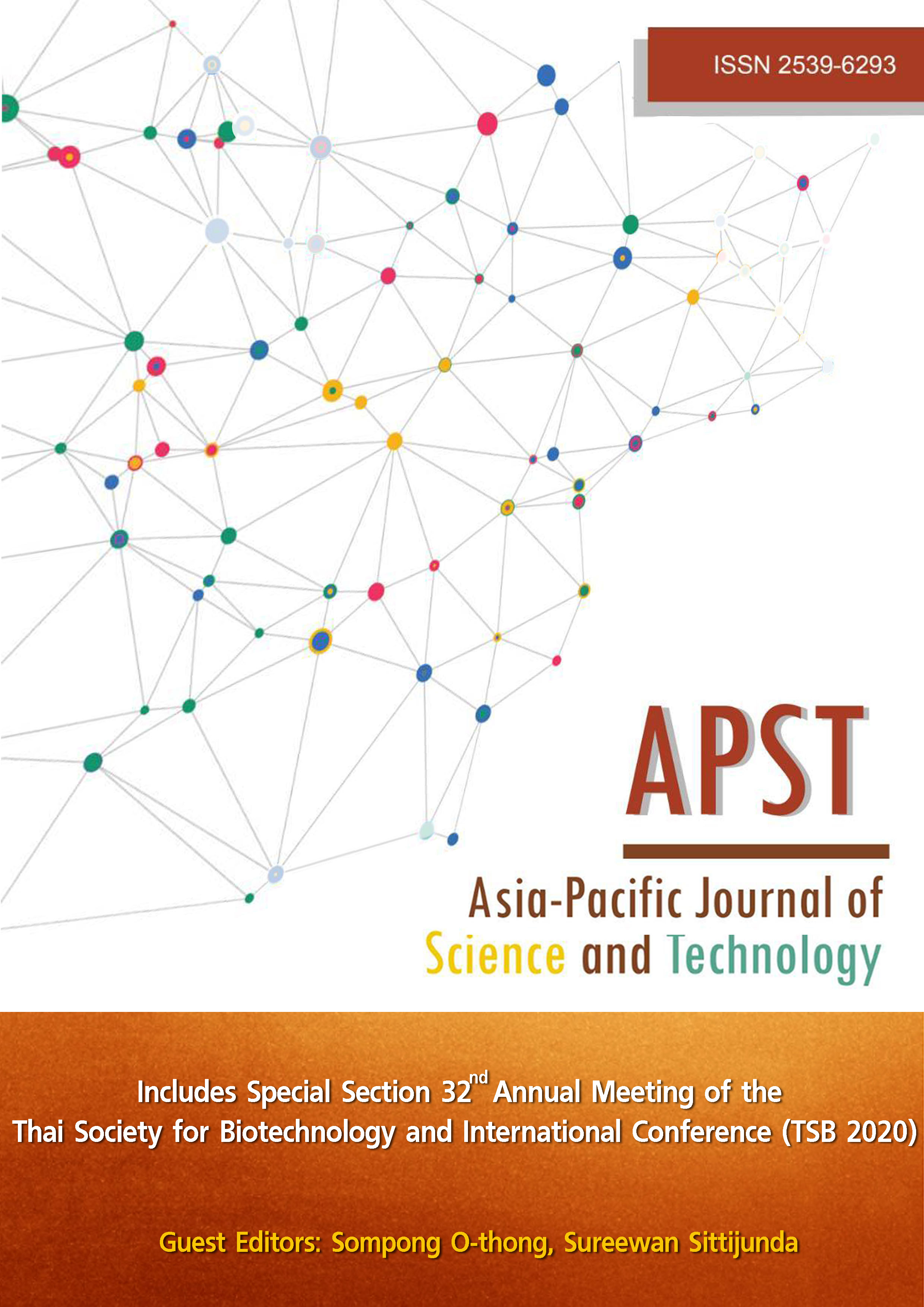Biological activities of crude exopolysaccharides produced by the bacteria isolated from plasmodia of slime molds
Main Article Content
Abstract
Slime molds are an unusual group of fungus-like protozoans, and one of their trophic stages (the plasmodium) is often found to be associated with certain unique bacteria not normally found in their regular habitats. Four different strains of bacteria were previously isolated from plasmodia (generated from fruiting bodies under laboratory conditions) of the slime molds Physarella oblonga and Fuligo septica. The bacteria were genetically classified as members of the genera Enterobacter, Stenotrophomonas, and Alcaligenes. The crude exopolysaccharides (EPSs) from the four species of bacteria were isolated and evaluated for their antioxidant and anti-proliferative activities. Mild in vitro antioxidant activities were recorded for all the samples. However, at a concentration of 1 mg/mL, the crude EPSs from Enterobacter sp. (C1) and Stenotrophomonas sp. 1 (C2) showed significant anti-proliferative activities against HeLa cervical cancer cells, with the antiproliferative rates of 41.31% and 36.19%, respectively. Remarkably, they displayed negligible antiproliferative activities toward bovine aortic endothelial cells. These data suggested that further investigations, including purification of the EPS samples and evaluation of their cytotoxicity against HeLa cells, should be carried out.
Article Details
References
[2] Dembitsky VM, Řezanka T, Spížek J, Hanuš LO. Secondary metabolites of slime molds (myxomycetes). Phytochemistry. 2005;66(7):747-769.
[3] Tran HT, Adamatzky A. Uses and potential: summary of the biomedical and engineering applications of Myxomycetes in the 21st century. In: Rojas C, Stephenson S, editors. Myxomycetes: Academic Press; 2017, p. 365-387.
[4] Ishibashi M. Study on myxomycetes as a new source of bioactive natural products. Yakugaku zasshi.. 2007;127(9):1369-1381.
[5] Cohen AL. Nutrition of the myxomycetes. II. Relations between plasmodia, bacteria, and substrate in two-membered culture. Bot Gaz. 1941;103(2):205-224.
[6] Venkataramani R, Daniel L. Bacterial associates of the slime mould Physarum nicaraguense Macbr. Proceedings: Plant Sciences. 1987;97(6):469-473.
[7] Öner ET. Microbial production of extracellular polysaccharides from biomass. In: Fang Z, editor. Pretreatment Techniques for Biofuels and Biorefineries. Green Energy and Technology. Berlin: Springer; 2013, p. 35-56.
[8] Singha TK. Microbial extracellular polymeric substances: production, isolation and applications. IOSR J Pharm. 2012;2(2):271-281.
[9] Li S, Huang R, Shah NP, Tao X, Xiong Y, Wei H. Antioxidant and antibacterial activities of exopolysaccharides from Bifidobacterium bifidum WBIN03 and Lactobacillus plantarum R315. J Dairy Sci. 2014;97(12):7334-7343.
[10] Lin ES. Production of exopolysaccharides by submerged mycelial culture of Grifola frondosa TFRI1073 and their antioxidant and antiproliferative activities. World J Microbiol Biotechnol. 2011;27(3):555-561.
[11] Nguyen DT, Nguyen TH. Detection on antioxidant and cytotoxicity activities of exopolysaccharides isolated in plant-originated Lactococcus lactis. Biomed Pharmacol J. 2015;7(1):33-38.
[12] Vidhyalakshmi R, Vallinachiyar C. Apoptosis of human breast cancer cells (MCF-7) induced by polysacccharides produced by bacteria. J Cancer Sci Ther. 2013;5(2):31-4.
[13] Valepyn E, Berezina N, Paquot M. Optimization of production and preliminary characterization of new exopolysaccharides from Gluconacetobacter hansenii LMG1524. Adv Microbiol. 2012;2(4):488-496.
[14] Hassan EM, Matloub AA, Aboutabl ME, Ibrahim NA, Mohamed SM. Assessment of anti-inflammatory, antinociceptive, immunomodulatory, and antioxidant activities of Cajanus cajan L. seeds cultivated in Egypt and its phytochemical composition. Pharm Biol. 2016;54(8):1380-1391.
[15] Molyneux P. The use of the stable free radical diphenylpicrylhydrazyl (DPPH) for estimating antioxidant activity. Songklanakarin J Sci Technol. 2004;26(2):211-219.
[16] Liu CT, Chu FJ, Chou CC, Yu RC. Antiproliferative and anticytotoxic effects of cell fractions and exopolysaccharides from Lactobacillus casei 01. Mutat Res Genet Toxicol Environ Mutagene. 2011; 721(2):157-162.
[17] Chi Z, Su C, Lu W. A new exopolysaccharide produced by marine Cyanothece sp. 113. Bioresour technol. 2007;98(6):1329-1332.
[18] Do TT, Lai TN, Stephenson SL, Tran HT. Cytotoxicity activities and chemical characteristics of exopolysaccharides and intracellular polysaccharides of Physarum polycephalum microplasmodia. BMC Biotechnol. 2021;21(1):1-15.
[19] Leung PH, Zhao S, Ho KP, Wu JY. Chemical properties and antioxidant activity of exopolysaccharides from mycelial culture of Cordyceps sinensis fungus Cs-HK1. Food Chem. 2009;114(4):1251-1256.
[20] Parikh A, Madamwar D. Partial characterization of extracellular polysaccharides from cyanobacteria. Bioresour Technol. 2006;97(15):1822-1827.
[21] Zhao K, Jin M, Chen Q, Zheng PS. Polysaccharides produced by Enterobacter cloacae induce apoptosis in cervical cancer cells. Int J Biol Macromol. 2015;72:960-964.
[22] Li W, Ji J, Tang W, Rui X, Chen X, Jiang M, et al. Characterization of an antiproliferative exopolysaccharide (LHEPS-2) from Lactobacillus helveticus MB2-1. Carbohydr Polym. 2014;105:334-340.
[23] Asker MS, El Sayed OH, Mahmoud MG, Yahya SM, Mohamed SS, Selim MS, et al. Production of exopolysaccharides from novel marine bacteria and anticancer activity against hepatocellular carcinoma cells (HepG2). 2018;42(1):1-9.
[24] Suresh Kumar A, Mody K, Jha B. Bacterial exopolysaccharides-a perception. J Basic Microbiol. 2007; 47(2):103-117.


